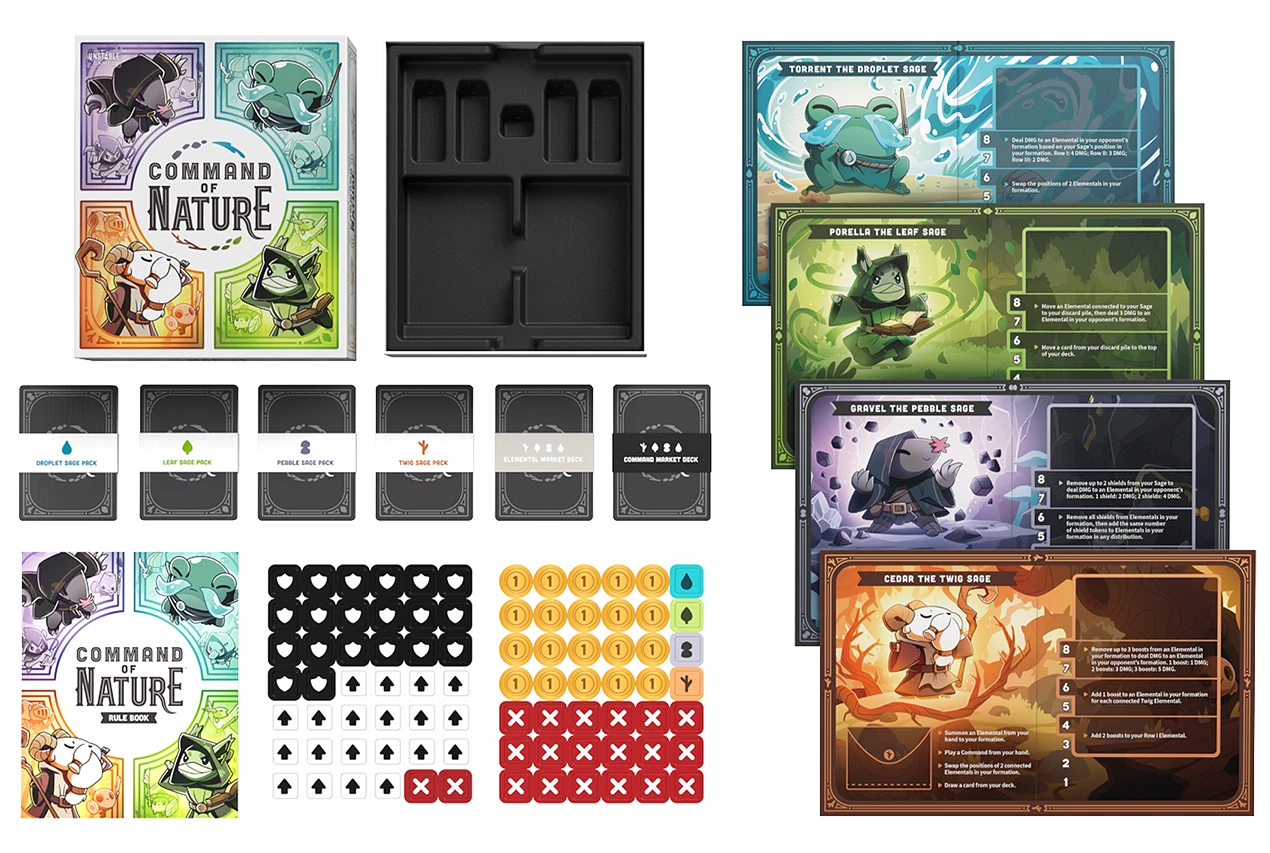In Command of Nature from Unstable Games, players must harness the magic of the forest and go head-to-head with rival Sages in a strategic deck-builder. Successfully Kickstarted to the tune of over $2 million, Ramy Badie has created a super cute deck management fighting game for players of all levels.
What’s in the box?

The base version of Command of Nature has 4 sage boards, 4 sage packs, 4 level tracker tokens, an elemental market deck, a command market deck, and 20 double-sided tokens each for boost, shield, damage, and gold. Plus a rulebook. The sages are themed, so there is a droplet, leaf, pebble, and twig.
Sage packs come with 16 cards split up between champion, elemental, warrior, and command cards, plus an individual sage card.
I have to say this was my favorite game to unbox in the epic string of post GenCon game adventure I’ve been on, because all I had to do was punch out the tokens and put them in the insert. That was it. The components themselves are really well done, and I love the art and illustrations on the boards and cards! The rulebook has great detailed illustrations, but is unfortunately a tad confusing.
How’s it play?
Command of Nature is made to play with two or four players. Players set up their sage board with the level tracker token, elemental champions face down in the designated area corresponding to its number, and the remaining elementals create a formation which consists of 3 rows where elementals are summoned.
In a two player game, there are three rows, and each row has the number of cards as the row, so 1 row has one card, the 2nd row has two cards, and so forth. The various cards are separated and placed based on the rules, and everything else is shuffled and placed facedown to form your deck, with space next to it for discarding.
The Command and Elemental market decks are created from all the cards that don’t belong to a specific Sage pack, and then the top three of each deck are flipped.

Turns are divided into four phases. Players use daybreak effects in any order if they can use them in Phase I, but if they move to Phase II without using them, they can’t use the effects later in the turn. In Phase II, players spend up to 4 action point to perform standard and faction actions, and can do up to 4 of those actions in the turn. Actions include summoning an elemental to the “board”, playing a command, drawing a card, or swapping two connected elements around in the formation.
As players defeat an opponent’s elemental, they increase their level by 1, and can unlock three different faction actions. These actions cost 1 action point, and can be used once per turn.
Then in Phase III, players can use their gold to buy cards from the market, sell cards for more gold, or refresh the markets. Finally in Phase IV, players clean their hands by discarding any number of cards and draw until there are five cards in hand.
To win, one player must defeat the other’s Sage, or if in a four player (two teams) game, both of the opposing Sages must be defeated.
The verdict?
What’s fun about this game is that each of the elemental factions have unique gameplay styles. The Pebble faction tries to defend with shield generation, the Droplet focuses on card advantage and formation manipulation, while Twig focuses on offense, and Leaf focuses on deck and discard pile manipulation. Having the faction actions adds a second level of strategy beyond just trying to play certain cards to win.
Importantly, if your Sage is taken out of the formation, you’ve lost Command of Nature! However, there are some complications in the rulebook, which made play slower as we tried to figure out what exactly we could, or could not do.

Some of the factions feel a bit overpowered than others. For example, the Pebble faction has a champion who gains shields anytime an Elemental leaves the formation, whereas Droplet’s level 4 champion allows the player to draw a card whenever an Elemental is attacked. This seems like it would be useful, but only if the card drawn is something to defend against an attack, or is an attack command that might be useful later. A shield is immediately useful!
You could say this is part of the game’s strategic offering, but playing through the game can feel overly frustrating because of the different effects on cards. Similarly, a 2×2 game can take a long time. I also wish there had been something on the player boards to keep track of action points for each Phase II. The level tracker is a token, and there could have been a AP tracker too.
Still, I did have fun playing Command of Nature and plan to play it again!
You can grab a copy directly from Unstable Games for $16.
Images and review copy courtesy of Unstable Games
Have strong thoughts about this piece you need to share? Or maybe there’s something else on your mind you’re wanting to talk about with fellow Fandomentals? Head on over to our Community server to join in the conversation!

